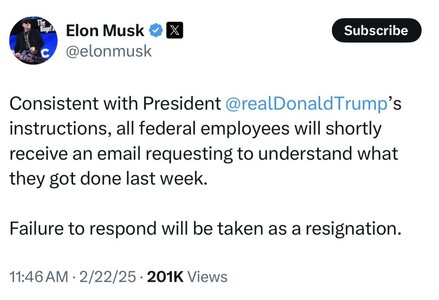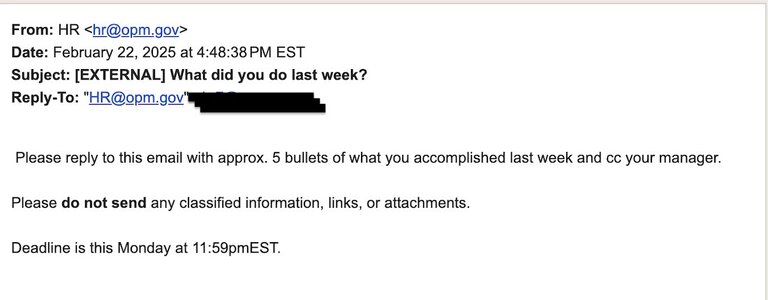Navigation
Install the app
How to install the app on iOS
Follow along with the video below to see how to install our site as a web app on your home screen.
Note: This feature may not be available in some browsers.
More options
You are using an out of date browser. It may not display this or other websites correctly.
You should upgrade or use an alternative browser.
You should upgrade or use an alternative browser.
Trump Fires Officials, Mass Firings Catch-All | Elon email - respond or lose your job PART 2
- Thread starter nycfan
- Start date
- Replies: 247
- Views: 5K
- Politics
- Messages
- 14,031
“… The Office of Community Planning and Development, part of the Department of Housing and Urban Development, pays to rebuild homes and other recovery efforts after the country’s worst disasters, such as Hurricane Helene in North Carolina and Hurricane Milton in Florida.
The administration plans to cut the staff in that office by 84 percent, according to a document obtained by The New York Times. The number of workers would be cut to 150, from 936 when Mr. Trump took office last month.
Those cuts could slow the distribution of recovery money to North Carolina and other recent disasters, depending how quickly they happen.
… some disasters are so big that they exceed FEMA’s funding, or the damage doesn’t fit neatly within FEMA’s programs. When that happens, Congress can choose to provide additional help, through a program at HUD called the Community Development Block Grant — Disaster Recovery.
… As disasters have grown more frequent and severe, HUD’s disaster recovery program has become central to the country’s strategy for coping with climate change. During the 1990s, Congress typically gave the program a few hundred million dollars a year. Over the past decade, by contrast, Congress has often provided billions or even tens of billions annually.
HUD’s disaster recovery money also comes with fewer strings attached. The money is largely used to rebuild homes that were either uninsured or underinsured, which the Federal Emergency Management Agency does not pay for. It also goes toward rebuilding infrastructure that’s not covered by FEMA, like the private roads and bridges that were significantly damaged by Helene in North Carolina.
The money can also be used for job training, to help workers whose employers went out of business after a disaster.
Because state and local officials are often overwhelmed by a disaster, and because the influx of federal funds is large and quick, one of HUD’s main jobs is ensuring the money isn’t lost to waste, fraud or abuse. That includes tasks like helping state and local governments set up systems to avoid paying contractors twice, according to a former official who worked on the program. It can also mean more complicated tasks like coordinating HUD’s grants with other federal disaster programs. …”
- Messages
- 14,031
Cont’d
“… Deep cuts to staffing levels would make it harder for HUD to prevent fraud, waste and abuse, according to two former officials familiar with the program who spoke on the condition of anonymity out of fear of retaliation. The cuts are being dictated by the so-called Department of Government Efficiency, whose stated goal is to reduce fraud, waste and abuse.
The community planning and development office is responsible for managing other spending programs beyond disaster recovery. Those include paying for infrastructure upgrades like sewers and sidewalks, affordable housing projects and programs like Meals on Wheels. …”
——
My dad ran Meals on Wheels out of his community action agency for decades. Small dollar investment that goes a long way to feeding people (seniors) with limited mobility and limited resources.
“… Deep cuts to staffing levels would make it harder for HUD to prevent fraud, waste and abuse, according to two former officials familiar with the program who spoke on the condition of anonymity out of fear of retaliation. The cuts are being dictated by the so-called Department of Government Efficiency, whose stated goal is to reduce fraud, waste and abuse.
The community planning and development office is responsible for managing other spending programs beyond disaster recovery. Those include paying for infrastructure upgrades like sewers and sidewalks, affordable housing projects and programs like Meals on Wheels. …”
——
My dad ran Meals on Wheels out of his community action agency for decades. Small dollar investment that goes a long way to feeding people (seniors) with limited mobility and limited resources.
- Messages
- 1,536
“A Northern Virginia couple is hashing out their next steps after the husband, a 13-year, disabled military veteran and nearly two-year information technology technician with the Federal Emergency Management Agency, was fired Monday, as part of the newly created Department of Government Efficiency’s efforts to shrink the federal workforce.
… Because they are concerned about possible retaliation and a likely appeal to the Merit Systems Protection Board, the couple asked WTOP not to use their names for this story.
The man pointed to the fact that his performance at FEMA was upgraded to “career conditional,” a step between one year and three years, and he was not a “probationary” employee. At three years he would have qualified for “career” status. He also cited his military service, disability status and exceptional performance reviews.
“I was all in the range of fours, which means exceeding expectations,” he said.
… The termination is complicated by the fact that last November they supported Donald Trump when he sought the White House for a second term.
“I voted for Donald Trump. But this is not what I was expecting,” he said. “We didn’t think they were going to take a chainsaw to a silk rug.”
… The man’s wife said they also believed his 13 years of military service in the Navy and Air Force Reserves, with an honorable discharge as an E-4, would have offered him more protection against DOGE cuts.
“I recognize there are a lot of cuts that need to be made, but this is not the one that you think will happen to your family,” she said.
“I encouraged him to take the job there, because he loved working for the agency, and I think it has a good mission.” …”

- Messages
- 1,536
“… The Office of Community Planning and Development, part of the Department of Housing and Urban Development, pays to rebuild homes and other recovery efforts after the country’s worst disasters, such as Hurricane Helene in North Carolina and Hurricane Milton in Florida.
The administration plans to cut the staff in that office by 84 percent, according to a document obtained by The New York Times. The number of workers would be cut to 150, from 936 when Mr. Trump took office last month.
Those cuts could slow the distribution of recovery money to North Carolina and other recent disasters, depending how quickly they happen.
… some disasters are so big that they exceed FEMA’s funding, or the damage doesn’t fit neatly within FEMA’s programs. When that happens, Congress can choose to provide additional help, through a program at HUD called the Community Development Block Grant — Disaster Recovery.
… As disasters have grown more frequent and severe, HUD’s disaster recovery program has become central to the country’s strategy for coping with climate change. During the 1990s, Congress typically gave the program a few hundred million dollars a year. Over the past decade, by contrast, Congress has often provided billions or even tens of billions annually.
HUD’s disaster recovery money also comes with fewer strings attached. The money is largely used to rebuild homes that were either uninsured or underinsured, which the Federal Emergency Management Agency does not pay for. It also goes toward rebuilding infrastructure that’s not covered by FEMA, like the private roads and bridges that were significantly damaged by Helene in North Carolina.
The money can also be used for job training, to help workers whose employers went out of business after a disaster.
Because state and local officials are often overwhelmed by a disaster, and because the influx of federal funds is large and quick, one of HUD’s main jobs is ensuring the money isn’t lost to waste, fraud or abuse. That includes tasks like helping state and local governments set up systems to avoid paying contractors twice, according to a former official who worked on the program. It can also mean more complicated tasks like coordinating HUD’s grants with other federal disaster programs. …”


MOUNTAINH33L
Distinguished Member
- Messages
- 334
I remember the clip of that sheriff from Spartanburg bawling his eyes out in front of that Fox "News" reporter going, "WE NEED TRUMP BACK! THIS WOULDN'T HAPPEN UNDER TRUMP!!!"
<insert jaguar gif here for the lolz>
- Messages
- 963
Immunity planning and development office is responsible for managing other spending programs beyond disaster recovery. Those include paying for infrastructure upgrades like sewers and sidewalks, affordable housing projects and programs like Meals on Wheels. …”
My sister retired and recently started delivering Meals on Wheels a couple times a month and plans on doing more. Sone heart braking and warming stories behind the recipitents.——
My dad ran Meals on Wheels out of his community action agency for decades. Small dollar investment that goes a long way to feeding people (seniors) with limited mobility and limited resources.
superrific
Legend of ZZL
- Messages
- 5,188
Well, guess I won't be using the mail.
They are 100% going to use this to fuck with the election. Mail in ballots, etc. Democratic fundraising fliers, etc.
- Messages
- 14,031
“…
The Department of Energy spent this week trying to contain the fallout from its DOGE-directed firing and rehiring of a brace of nuclear safety officials by painting them as non-critical staff who “held primarily administrative and clerical roles.”
But this wasn’t close to true, current and recently retired NNSA employees tell The Bulwark. In fact, one of the officials who was locked out of his work accounts was Acting Chief of Defense Nuclear Safety James Todd, a senior executive official and the top authority for all nuclear-safety matters in the agency.
… At the agency’s Los Alamos field office alone, there was the site’s emergency preparedness manager, who is responsible for maintaining plans to minimize the effects of a nuclear accident on site and in surrounding areas. There was the radiation protection manager, responsible for minimizing radiation exposure to on-site workers. There was the security manager, the fire protection engineer, and two facility representatives, who are the office’s day-to-day eyes and ears on site manufacturing facilities.
Media reports have treated the firings as a deeply unwise DOGE hatchet job that was, thankfully, quickly reversed. And it’s true that earlier this week, nearly all the affected employees were notified that they were welcome back at their jobs. But at the Los Alamos nuclear facility and across NNSA, shell-shocked employees remain unsure whether or how soon the axe might fall again. Many, sources say, are now eyeing early retirement or thinking about finding other work. …”
- Messages
- 1,394
“…
The Department of Energy spent this week trying to contain the fallout from its DOGE-directed firing and rehiring of a brace of nuclear safety officials by painting them as non-critical staff who “held primarily administrative and clerical roles.”
But this wasn’t close to true, current and recently retired NNSA employees tell The Bulwark. In fact, one of the officials who was locked out of his work accounts was Acting Chief of Defense Nuclear Safety James Todd, a senior executive official and the top authority for all nuclear-safety matters in the agency.
… At the agency’s Los Alamos field office alone, there was the site’s emergency preparedness manager, who is responsible for maintaining plans to minimize the effects of a nuclear accident on site and in surrounding areas. There was the radiation protection manager, responsible for minimizing radiation exposure to on-site workers. There was the security manager, the fire protection engineer, and two facility representatives, who are the office’s day-to-day eyes and ears on site manufacturing facilities.
Media reports have treated the firings as a deeply unwise DOGE hatchet job that was, thankfully, quickly reversed. And it’s true that earlier this week, nearly all the affected employees were notified that they were welcome back at their jobs. But at the Los Alamos nuclear facility and across NNSA, shell-shocked employees remain unsure whether or how soon the axe might fall again. Many, sources say, are now eyeing early retirement or thinking about finding other work. …”
But but but elon is surgically rooting out corruption and inefficiency!!!!!!!!!!!!!!!!!!!!!!!!!!
- Messages
- 14,031
GSA says workers who took ‘fork’ won’t get a full payout — then reverses itself
The inconsistency marks the latest twist in an error-plagued rollout of the Trump administration’s sweeping effort to incentivize federal workers to quit.“Officials with the General Services Administration told staff in emails sent last weekend that probationary workers who took the Trump administration’s deferred resignation offer would not necessarily be paid through Sept. 30, going back on a guarantee made to all federal workers.
Instead, GSA leaders wrote in messages obtained by The Washington Post, probationary staff would see their payments stop when their probationary period expired, if that date came before the end date of the resignation program.
Hours after The Post contacted the U.S. Office of Personnel Management about the issue, GSA reversed itself, communicating the decision in a note from the agency’s chief of staff that said, “Things change.”
Probationary employees will receive their pay through Sept. 30 “regardless of their probation end date,” he wrote in an email obtained by The Post.
The inconsistency marks the latest twist in an error-plagued rollout of the Trump administration’s sweeping effort to incentivize federal workers to quit — a deal the government promised repeatedly would permit all approved employees to get paid for not working through September. Dozens of probationary workers in recent interviews have detailed challenges with taking the deal, as agencies raced to implement a Trump administration directive to shed those jobs.
In particular, some probationary employees who accepted the resignation offer reported they were fired anyway, spurring confusion and chaos. When The Post contacted OPM to ask about the firings, agencies began reinstating terminated workers to the resignation program. The mistaken firings and corrections transpired at several agencies including the Education Department and the Agriculture Department, The Post found. …”
UNCBAdookJD
Distinguished Member
- Messages
- 333
Their gross incompetence is our only hope.These guys understand what's happening so little that they'd organize a circle jerk in a brothel.
- Messages
- 14,031
Share:


